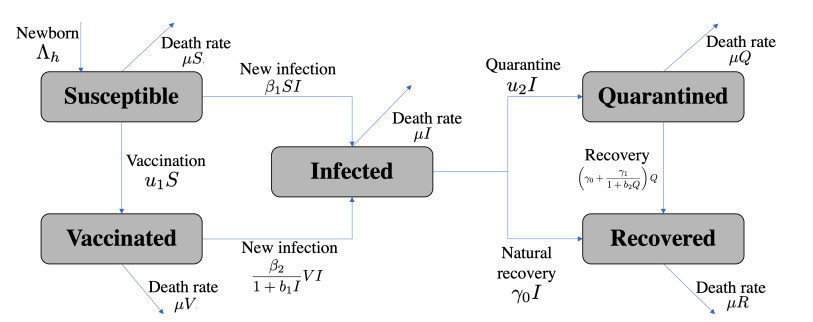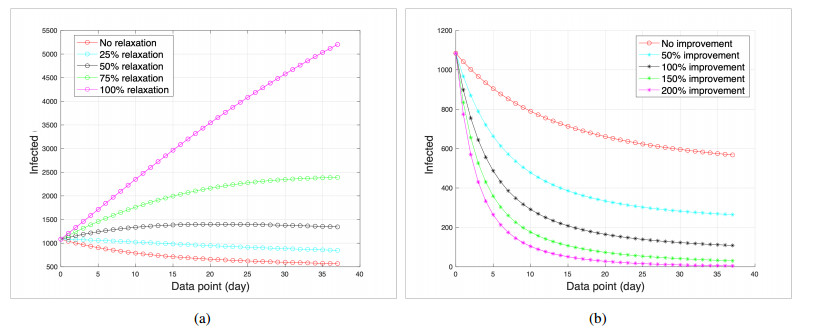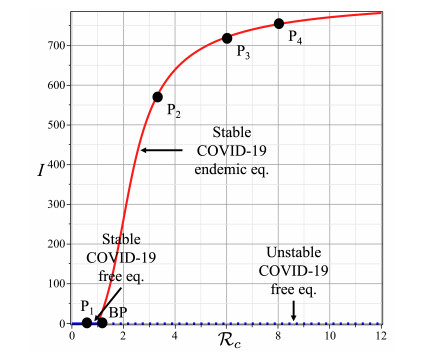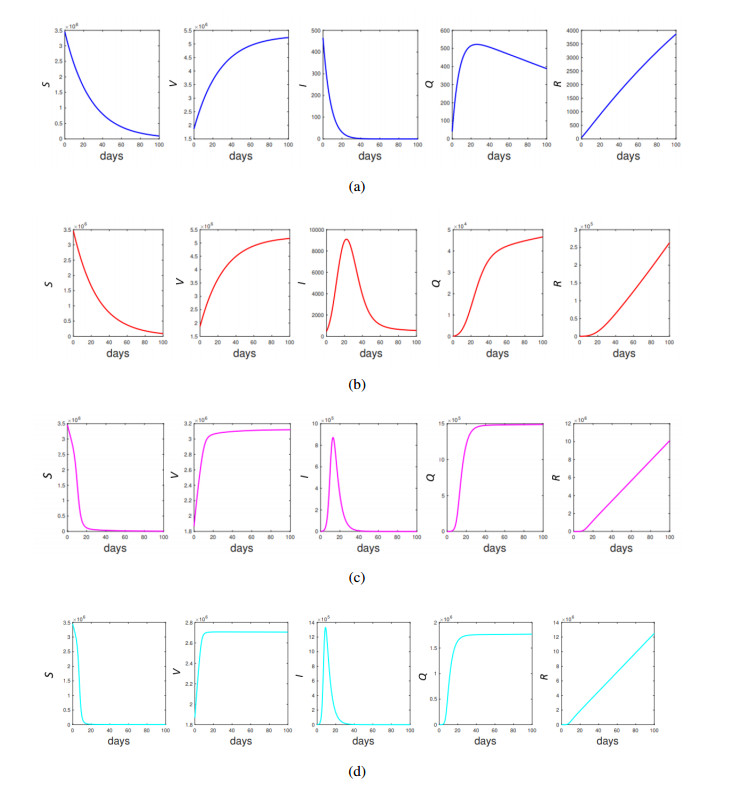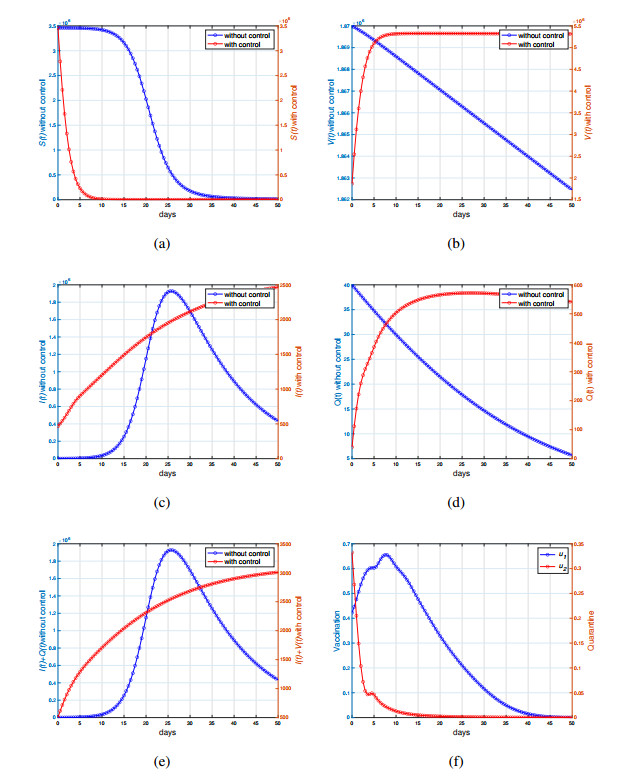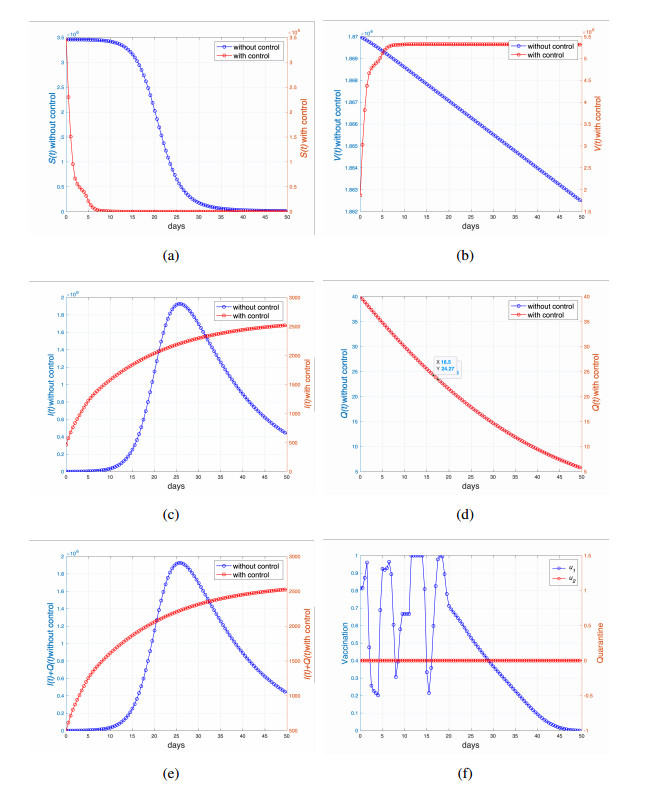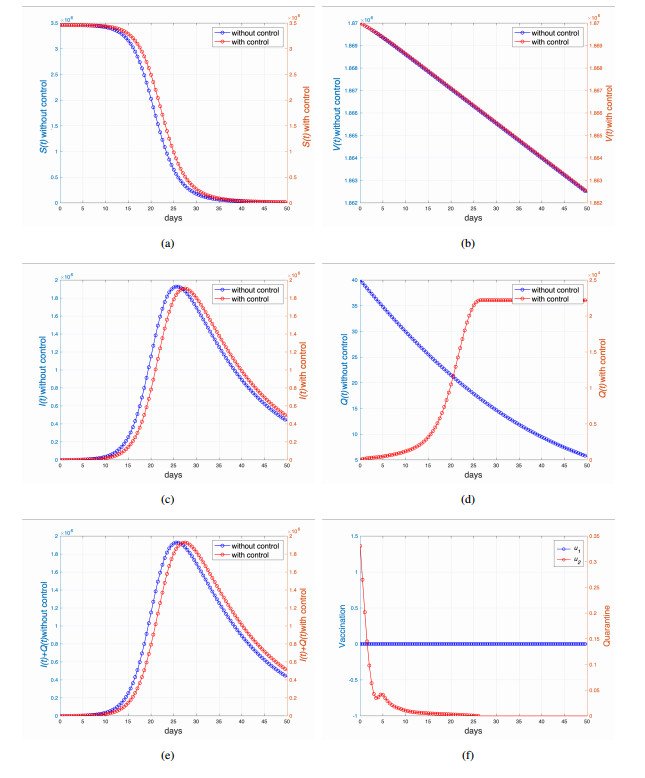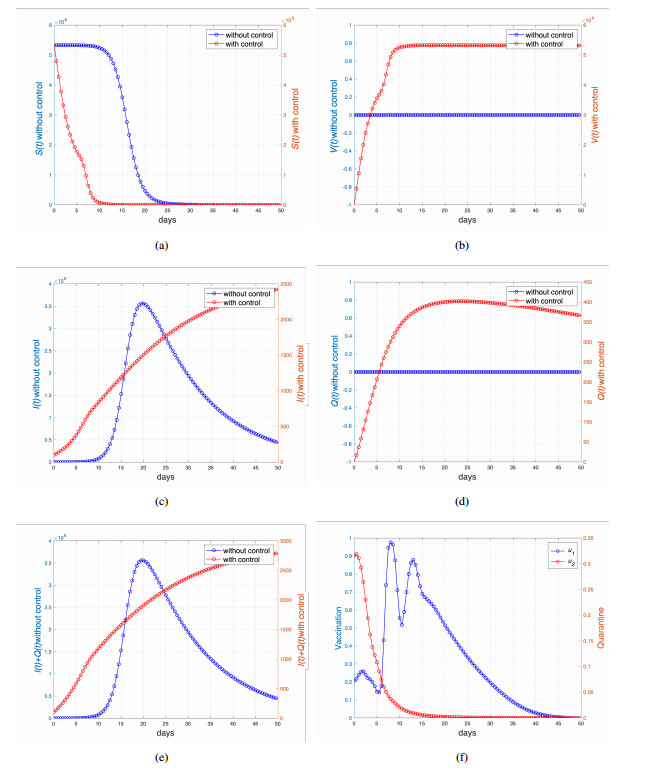|
[1]
|
The World Health Organization (WHO), Coronavirus disease (covid-19) pandemic, 2023. Available from: https://www.who.int/europe/emergencies/situations/covid-19.
|
|
[2]
|
Centers for Disease Control and Prevention, Symptoms of covid-19, 2023. Available from: https://www.cdc.gov/coronavirus/2019-ncov/symptoms-testing/symptoms.html.
|
|
[3]
|
The World Health Organization (WHO), Indonesia situation of covid-19, 2023. Available from: https://covid19.who.int/region/searo/country/id.
|
|
[4]
|
Ministry of State Apparatus Utilization and Bureaucratic Reform, Indonesia (KEMENPANRI), Indonesia telah bergerak menuju endemi covid-199, 2023. Available from: https://www.menpan.go.id/site/berita-terkini/berita-daerah/indonesia-telah-bergerak-menuju-endemi-covid-19.
|
|
[5]
|
Communication Team of the National Committee for Handling Corona Virus Disease 2019 (Covid-19) and National Economic Recovery, Indonesia, Waspadai komorbid, salah satu faktor risiko yang memperparah gejala covid-19, 2022. Available from: https://covid19.go.id/artikel/2022/02/15/waspadai-komorbid-salah-satu-faktor-risiko-yang-memperparah-gejala-covid-19.
|
|
[6]
|
The Ministry of Health Republic Indonesia (KEMENKES RI), Covid 19 update, 2023. Available from: https://www.mayoclinic.org/diseases conditions/coronavirus/in-depth/herd-immunity-and coronavirus.
|
|
[7]
|
K. Cardwell, B. Clyne, N. Broderick, B. Tyner, G. Masukume, L. Larkin, et al., Lessons learnt from the covid-19 pandemic in selected countries to inform strengthening of public health systems: a qualitative study, Public Health, 225 (2023), 343–352. https://doi.org/10.1016/j.puhe.2023.10.024 doi: 10.1016/j.puhe.2023.10.024

|
|
[8]
|
F. M. Ekawati, M. Muchlis, N. G. Iturrieta-Guaita, D. A. D. Putri, Recommendations for improving maternal health services in indonesian primary care under the covid-19 pandemic: Results of a systematic review and appraisal of international guidelines, Sex. Reprod. Healthcare, 35 (2023), 100811. https://doi.org/10.1016/j.srhc.2023.100811 doi: 10.1016/j.srhc.2023.100811

|
|
[9]
|
A. Rupp, P. Limpaphayom, Benefits of corporate social responsibility during a pandemic: Evidence from stock price reaction to covid-19 related news, Res. Int. Bus. Finance, 68 (2024), 102169. https://doi.org/10.1016/j.ribaf.2023.102169 doi: 10.1016/j.ribaf.2023.102169

|
|
[10]
|
I. D. Selvi, Online learning and child abuse: the covid-19 pandemic impact on work and school from home in indonesia, Heliyon, 8 (2022), e08790. https://doi.org/10.1016/j.heliyon.2022.e08790 doi: 10.1016/j.heliyon.2022.e08790

|
|
[11]
|
R. Banerjee, R. K. Biswas, Fractional optimal control of compartmental sir model of covid-19: Showing the impact of effective vaccination, IFAC-PapersOnLine, 55 (2022), 616–622. https://doi.org/10.1016/j.ifacol.2022.04.101 doi: 10.1016/j.ifacol.2022.04.101

|
|
[12]
|
M. L. Diagne, H. Rwezaura, S. Y. Tchoumis, J. M. Tchuenche, A mathematical model of covid-19 with vaccination and treatment, Comput. Math. Methods Med., 2021 (2021), 1250129. https://doi.org/10.1155/2021/1250129 doi: 10.1155/2021/1250129

|
|
[13]
|
J. N. Paul, I. S. Mbalawata, S. S. Mirau, L. Masandawa, Mathematical modeling of vaccination as a control measure of stress to fight covid-19 infections, Chaos, Solitons Fractals, 166 (2023), 112920. https://doi.org/10.1016/j.chaos.2022.112920 doi: 10.1016/j.chaos.2022.112920

|
|
[14]
|
B. Yang, Z. Yu, Y. Cai, The impact of vaccination on the spread of covid-19: Studying by a mathematical model, Physica A, 590 (2022), 126717. https://doi.org/10.1016/j.physa.2021.126717 doi: 10.1016/j.physa.2021.126717

|
|
[15]
|
A. Ayalew, M. Yezbalew, T. Tilahun, T. Tesfa, Mathematical model and analysis on the impacts of vaccination and treatment in the control of the covid-19 pandemic with optimal control, J. Appl. Math., 2023 (2023), 8570311. https://doi.org/10.1155/2023/8570311 doi: 10.1155/2023/8570311

|
|
[16]
|
C. W. Chukwu, R. T. Alqahtani, F. F. Herdicho, A pontryagin's maximum principle and optimal control model with cost-effectiveness analysis of the covid-19 epidemic, Decis. Anal. J., 8 (2023), 100273. https://doi.org/10.1016/j.dajour.2023.100273 doi: 10.1016/j.dajour.2023.100273

|
|
[17]
|
S. Bhatter, K. Jangid, A. Abidemi, K. M. Owolabi, S. D. Purohit, A new fractional mathematical model to study the impact of vaccination on covid-19 outbreaks, Decis. Anal. J., 6 (2023), 100156. https://doi.org/10.1016/j.dajour.2022.100156 doi: 10.1016/j.dajour.2022.100156

|
|
[18]
|
C. Xu, Y. Yu, G. Ren, Y. Sun, X. Si, Stability analysis and optimal control of a fractional-order generalized seir model for the covid-19 pandemic, Appl. Math. Comput., 457 (2023), 128210. https://doi.org/10.1016/j.amc.2023.128210 doi: 10.1016/j.amc.2023.128210

|
|
[19]
|
C. M. Wachira, G. O. Lawi, L. O. Omondi, Travelling wave analysis of a diffusive covid-19 model, J. Appl. Math., 2022 (2022), 60522274. https://doi.org/10.1155/2022/6052274 doi: 10.1155/2022/6052274

|
|
[20]
|
B. Barnes, I. Takyi, B. E. Owusu, F. Ohene Boateng, A. Saahene, E. Saarah Baidoo, et al., Mathematical modelling of the spatial epidemiology of covid-19 with different diffusion coefficients, Int. J. Differ. Equations, 2022, 7563111. https://doi.org/10.1155/2022/7563111 doi: 10.1155/2022/7563111

|
|
[21]
|
A. El Koufi, N. El Koufi, Stochastic differential equation model of covid-19: Case study of pakistan, Results Phys., 34 (2022), 105218. https://doi.org/10.1016/j.rinp.2022.105218 doi: 10.1016/j.rinp.2022.105218

|
|
[22]
|
M. Pajaro, N. M. Fajar, A. A. Alonso, I. Otero-Muras, Stochastic sir model predicts the evolution of covid-19 epidemics from public health and wastewater data in small and medium-sized municipalities: A one year study, Chaos, Solitons Fractals, 164 (2022), 112671. https://doi.org/10.1016/j.chaos.2022.112671 doi: 10.1016/j.chaos.2022.112671

|
|
[23]
|
V. V. Khanna, K. Chadaga, N. Sampathila, R. Chadaga, A machine learning and explainable artificial intelligence triage-prediction system for covid-19, Decis. Anal. J., 7 (2023), 100246. https://doi.org/10.1016/j.dajour.2023.100246 doi: 10.1016/j.dajour.2023.100246

|
|
[24]
|
K. Moulaei, M. Shanbehzadeh, Z. Mohammadi-Taghiabad, H. Kazemi-Arpanahi, Comparing machine learning algorithms for predicting covid-19 mortality, BMC Med. Inf. Decis. Making, 22 (2022), 1–12. https://doi.org/10.1186/s12911-021-01742-0 doi: 10.1186/s12911-021-01742-0

|
|
[25]
|
D. Aldila, S. H. Khoshnaw, E. Safitri, Y. R. Anwar, A. R. Bakry, B. M. Samiadji, et al., A mathematical study on the spread of covid-19 considering social distancing and rapid assessment: the case of jakarta, indonesia, Chaos Solitons Fractals, 139 (2020), 110042. https://doi.org/10.1016/j.chaos.2020.110042 doi: 10.1016/j.chaos.2020.110042

|
|
[26]
|
J. L. Gevertz, J. M. Greene, C. H. Sanchez-Tapia, E. D. Sontag, A novel covid-19 epidemiological model with explicit susceptible and asymptomatic isolation compartments reveals unexpected consequences of timing social distancing, J. Theor. Biol., 510 (2021), 110539. https://doi.org/10.1016/j.jtbi.2020.110539 doi: 10.1016/j.jtbi.2020.110539

|
|
[27]
|
I. A. Arik, H. K. Sari, S. I. Araz, Numerical simulation of covid-19 model with integer and non-integer order: The effect of environment and social distancing, Results Phys., 51 (2023), 106725. https://doi.org/10.1016/j.rinp.2023.106725 doi: 10.1016/j.rinp.2023.106725

|
|
[28]
|
S. Saharan, C. Tee, A covid-19 vaccine effectiveness model using the susceptible-exposed-infectious-recovered model, Healthcare Anal., 4 (2023), 100269. https://doi.org/10.1016/j.health.2023.10026 doi: 10.1016/j.health.2023.10026

|
|
[29]
|
A. I. Alaje, M. O. Olayiwola, A fractional-order mathematical model for examining the spatiotemporal spread of covid-19 in the presence of vaccine distribution, Healthcare Anal., 4 (2023), 100230. https://doi.org/10.1016/j.health.2023.100230 doi: 10.1016/j.health.2023.100230

|
|
[30]
|
R. Pino, V. M. Mendoza, E. A. Enriques, A. C. Velasco, R. Mendoza, An optimization model with simulation for optimal regional allocation of covid-19 vaccines, Healthcare Anal., 4 (2023), 100244. https://doi.org/10.1016/j.health.2023.100244 doi: 10.1016/j.health.2023.100244

|
|
[31]
|
O. J. Watson, G. Barnsley, J. Toor, A. B. Hogan, P. Winskill, A. C. Ghani, Global impact of the first year of covid-19 vaccination: a mathematical modelling study, Lancet Infect. Dis., 22 (2022), 1293–1302. https://doi.org/10.1016/S1473-3099(22)00320-6 doi: 10.1016/S1473-3099(22)00320-6

|
|
[32]
|
A. K. Paul, M. A. Kuddus, Mathematical analysis of a covid-19 model with double dose vaccination in bangladesh, Results Phys., 35 (2022), 105392. https://doi.org/10.1016/j.rinp.2022.105392 doi: 10.1016/j.rinp.2022.105392

|
|
[33]
|
O. I. Idisi, T. T. Yusuf, K. M. Owolabi, B. A. Ojokoh, A bifurcation analysis and model of covid-19 transmission dynamics with post-vaccination infection impact, Healthcare Anal., 3 (2023), 100157. https://doi.org/10.1016/j.health.2023.100157 doi: 10.1016/j.health.2023.100157

|
|
[34]
|
I. Ul Haq, N. Ullah, N. Ali, K. S. Nisar, A new mathematical model of covid-19 with quarantine and vaccination, Mathematics, 11 (2022), 142. https://doi.org/10.3390/math11010142 doi: 10.3390/math11010142

|
|
[35]
|
D. S. A. A. Reza, M. N. Billah, S. S. Shanta, Effect of quarantine and vaccination in a pandemic situation: A mathematical modelling approach, J. Math. Anal. Model., 2 (2021), 77–81. https://doi.org/10.48185/jmam.v2i3.318 doi: 10.48185/jmam.v2i3.318

|
|
[36]
|
Y. Gu, S. Ullah, M. A. Khan, Mathematical modeling and stability analysis of the covid-19 with quarantine and isolation, Results Phys., 34 (2022), 105284. https://doi.org/10.1016/j.rinp.2022.105284 doi: 10.1016/j.rinp.2022.105284

|
|
[37]
|
F. Wu, X. Liang, J. Lein, Modelling covid-19 epidemic with confirmed cases-driven contact tracing quarantine, Infect. Dis. Modell., 8 (2023), 415–426. https://doi.org/10.1016/j.idm.2023.04.001 doi: 10.1016/j.idm.2023.04.001

|
|
[38]
|
A. K. Saha, S. Saha, C. N. Podder, Effect of awareness, quarantine and vaccination as control strategies on covid-19 with co-morbidity and re-infection, Infect. Dis. Modell., 7 (2022), 660–689. https://doi.org/10.1016/j.idm.2022.09.004 doi: 10.1016/j.idm.2022.09.004

|
|
[39]
|
S. S. Musa, S. Queshi, S. Zhao, A. Yusuf, U. T. Mustapha, D. He, Mathematical modeling of covid-19 epidemic with effect of awareness programs, Infect. Dis. Modell., 6 (2021), 448–460. https://doi.org/10.1016/j.idm.2021.01.012 doi: 10.1016/j.idm.2021.01.012

|
|
[40]
|
A. A. Anteneh, Y. M. Bazazaw, S. Palanisam, Mathematical model and analysis on the impact of awareness campaign and asymptomatic human immigrants in the transmission of covid-19, Biomed Res. Int., 2022 (2022), 6260262. https://doi.org/10.1155/2022/6260262 doi: 10.1155/2022/6260262

|
|
[41]
|
M. A. Balya, B. O. Dewi, F. I. Lestari, G. Ratu, H. Rosuliyana, T. Windyhani, et al., Investigating the impact of social awareness and rapid test on a covid-19 transmission model, Commun. Biomathematical Sci., 4 (2021), 46–64. https://doi.org/10.5614/cbms.2021.4.1.5 doi: 10.5614/cbms.2021.4.1.5

|
|
[42]
|
A. K. Srivastav, M. Gosh, S. S. Bandekar, Modeling of covid-19 with limited public health resources: a comparative study of three most affected countries, Eur. Phys. J. Plus, 136 (2021), 359. https://doi.org/10.1140/epjp/s13360-021-01333-y doi: 10.1140/epjp/s13360-021-01333-y

|
|
[43]
|
U. M. Rifanti, A. R. Dewi, N. Nurlaili, S. T. Hapsari, Model matematika covid-19 dengan sumber daya pengobatan yang terbatas, J. Math. Appl., 18 (2021), 23–36. https://doi.org/10.12962/limits.v18i1.8207 doi: 10.12962/limits.v18i1.8207

|
|
[44]
|
S. Cakan, Dynamic analysis of a mathematical model with health care capacity for covid-19 pandemic, Chaos, Solitons, Fractals, 139 (2020), 110033. https://doi.org/10.1016/j.chaos.2020.110033 doi: 10.1016/j.chaos.2020.110033

|
|
[45]
|
I. I. Oke, Y. T. Oyebo, O. F. Fakoya, V. S. Benson, Y. T. Tunde, A mathematical model for covid-19 disease transmission dynamics with impact of saturated treatment: Modeling, analysis and simulation, Open Access Lib. J., 8 (2021), 1–20. https://doi.org/10.4236/oalib.1107332 doi: 10.4236/oalib.1107332

|
|
[46]
|
M. Elhia, L. Boujallal, M. Alkama, O. Balatif, M. Rachik, Set-valued control approach applied to a covid-19 model with screening and saturated treatment function, Complexity, 2020 (2020), 9501028. https://doi.org/10.1155/2020/9501028 doi: 10.1155/2020/9501028

|
|
[47]
|
J. K. Ghosh, S. K. Bhiswas, S. Sarkar, U. Ghosh, Mathematical modelling of covid-19: A case study of italy, Math. Comput. Simul., 194 (2022), 1–18. https://doi.org/10.1016/j.matcom.2021.11.008 doi: 10.1016/j.matcom.2021.11.008

|
|
[48]
|
R. T. Alqahtani, A. Ajbar, Study of dynamics of a covid-19 model for saudi arabia with vaccination rate, saturated treatment function and saturated incidence rate, Mathematics, 9 (2021), 3134. https://doi.org/10.3390/math9233134 doi: 10.3390/math9233134

|
|
[49]
|
I. Ali, S. U. Khan, Dynamics and simulations of stochastic covid 19 epidemic model using legendre spectral collocation method, AIMS Math., 8 (2023), 4220–4236. https://doi.org/10.3934/math.2023210 doi: 10.3934/math.2023210

|
|
[50]
|
S. S. Chaharborj, S. S. Chaharborj, J. H. Asl, P. S. Phang, Controlling pandemic covid-19 using optimal control theory, Results Phys., 26 (2021), 104311. https://doi.org/10.1016/j.rinp.2021.104311 doi: 10.1016/j.rinp.2021.104311

|
|
[51]
|
R. P. Kumar, S. Basu, P. K. Santra, D. Ghosh, G. S. Mahapatra, Optimal control design incorporating vaccination and treatment on six compartment pandemic dynamical system, Results Control Optim., 7 (2022), 100115. https://doi.org/10.1016/j.rico.2022.100115 doi: 10.1016/j.rico.2022.100115

|
|
[52]
|
T. Li, Y. Guo, Optimal control and cost-effectiveness analysis of a new covid-19 model for omicron strain, Physica A, 606 (2022), 128134. https://doi.org/10.1016/j.physa.2022.128134 doi: 10.1016/j.physa.2022.128134

|
|
[53]
|
A. Bilgram, P. G. Jensen, K. Y. Jørgensen, K. G. Larsen, M. Mikučionis, M. Muñiz, et al., An investigation of safe and near-optimal strategies for prevention of covid-19 exposure using stochastic hybrid models and machine learning, Decis. Anal. J., 5 (2022), 100141. https://doi.org/10.1016/j.dajour.2022.100141 doi: 10.1016/j.dajour.2022.100141

|
|
[54]
|
M. S. Khatun, S. Das, P. Das, Dynamics and control of an sitr covid-19 model with awareness and hospital bed dependency, Chaos, Solitons Fractals, 175 (2023), 114010. https://doi.org/10.1016/j.chaos.2023.114010 doi: 10.1016/j.chaos.2023.114010

|
|
[55]
|
Mayo Clinic, Herd immunity and covid-19: What you need to know, 2023. Available from: https://www.mayoclinic.org/diseases conditions/coronavirus/in-depth/herd-immunity-and coronavirus.
|
|
[56]
|
D. K. A. Mannan, K. M. Farhana, Knowledge, attitude and acceptance of a covid‐19 vaccine: a global cross‐sectional study, Int. Res. J. Bus. Social Sci., 6 (2020), 1–23.
|
|
[57]
|
S. M. Saeied, M. M. Saeied, I. A. Kabbash, S. Abdo, Vaccine hesitancy: beliefs and barriers associated with covid‐19 vaccination among egyptian medical students, J. Med. Virol., 93 (2021), 4280–4291. https://doi.org/10.1002/jmv.26910 doi: 10.1002/jmv.26910

|
|
[58]
|
M. O. Elgendy, M. E. A. Abdelrahim, Public awareness about coronavirus vaccine, vaccine acceptance, and hesitancy, J. Med. Virol., 93.(2021), 6535–6543. https://doi.org/10.1002/jmv.27199 doi: 10.1002/jmv.27199

|
|
[59]
|
S. Funk, E. Gilad, C. Watkins, V. A. A. Jansen, The spread of awareness and its impact on epidemic outbreaks, Proc. Natl. Acad. Sci., 106 (2009), 6872–6877. https://doi.org/10.1073/pnas.0810762106 doi: 10.1073/pnas.0810762106

|
|
[60]
|
G. Kelly, S. Petti, N. Noah, Covid-19, non-covid-19 and excess mortality rates not comparable across countries, Epidemiol. Infect., 149 (2021), e176. https://doi.org/10.1017/S0950268821001850 doi: 10.1017/S0950268821001850

|
|
[61]
|
S. Nourazari, S. R. Davis, R. Granovsky, R. Austin, D. J. Straff, J. W. Joseph, L. D. Sanchez, Decreased hospital admissions through emergency departments during the covid-19 pandemic, Am. J. Emerg. Med., 42 (2021), 203–210. https://doi.org/10.1016/j.ajem.2020.11.029 doi: 10.1016/j.ajem.2020.11.029

|
|
[62]
|
Statistics Center of West Java Province (BPS), Jumlah penduduk menurut kabupaten/kota (jiwa), 2018-2020, 2023. Available from: https://jabar.bps.go.id/indicator/12/133/1/jumlah-penduduk-menurut-kabupaten-kota.html.
|
|
[63]
|
A. Abidemi, J. O. Akanni, O. D. Makinde, A non-linear mathematical model for analysing the impact of covid-19 disease on higher education in developing countries, Healthcare Anal., 3 (2023), 100193. https://doi.org/10.1016/j.health.2023.100193 doi: 10.1016/j.health.2023.100193

|
|
[64]
|
E. A. Iboi, O. Sharomi, C. N. Ngonghala, A. B. Gumel, Mathematical modeling and analysis of covid-19 pandemic in nigeria, Math. Biosci. Eng., 17 (2020), 7192–7220. https://doi.org/10.3934/mbe.2020369 doi: 10.3934/mbe.2020369

|
|
[65]
|
Statistics Center of West Java Province (BPS), [komponen ipg] usia harapan hidup 2020-2022, 2023. Available from: https://jabar.bps.go.id/indicator/40/185/1/-komponen-ipg-usia-harapan-hidup-.html.
|
|
[66]
|
S. Olaniyi, O. S. Obabiyi, K. O. Okosun, A. T. Oladipo, S. O. Adewale, Athematical modelling and optimal cost-effective control of covid-19 transmission dynamics, Eur. Phys. J. Plus, 135 (2021), 1–20. https://doi.org/10.1140/epjp/s13360-020-00954-z doi: 10.1140/epjp/s13360-020-00954-z

|
|
[67]
|
A. Abate, A. Tiwari, S. Sastrys, Box invariance in biologically-inspired dynamical systems, Automatica, 45 (2009), 1601–1610. https://doi.org/10.1016/j.automatica.2009.02.028 doi: 10.1016/j.automatica.2009.02.028

|
|
[68]
|
P. Taylan, G. W. Weber, L. Liu, F. Yerlika-Ozkurt, On the foundations of parameter estimation for generalized partial linear models with b-splines and continuous optimization, Comput. Math. Appl., 60 (2010), 134–143. https://doi.org/10.1016/j.camwa.2010.04.040 doi: 10.1016/j.camwa.2010.04.040

|
|
[69]
|
A. A. Tappe, M. Schulze, R. Schenkendorf, Neural odes and differential flatness for total least squares parameter estimation, IFAC-PapersOnLine, 55 (2020), 421–426. https://doi.org/10.1016/j.ifacol.2022.09.131 doi: 10.1016/j.ifacol.2022.09.131

|
|
[70]
|
O. Aydogmuz, T. Ali Hakan, A modified multiple shooting algorithm for parameter estimation in odes using adjoint sensitivity analysis, Appl. Math. Comput., 390 (2021), 125644. https://doi.org/10.1016/j.amc.2020.125644 doi: 10.1016/j.amc.2020.125644

|
|
[71]
|
S. Khalilpourazari, H. Hashemi Doulabi, A. O. Ciftcioglu, G. W. Weber, Gradient-based grey wolf optimizer with gaussian walk: Application in modelling and prediction of the covid-19 pandemic, Expert Syst. Appl., 177 (2021), 114920. https://doi.org/10.1016/j.eswa.2021.114920 doi: 10.1016/j.eswa.2021.114920

|
|
[72]
|
P. Driesche, J. Watmough, Reproduction numbers and sub-threshold endemic equilibria for compartmental models of disease transmissions, Math. Biosci., 180 (2002), 29–48. https://doi.org/10.1016/S0025-5564(02)00108-6 doi: 10.1016/S0025-5564(02)00108-6

|
|
[73]
|
M. Martcheva, An Introduction to Mathematical Epidemiology, Springer, Berlin, Germany, 2015.
|
|
[74]
|
C. Castillo–Chavez, B. Song, Dynamical models of tuberculosis and their applications, Math. Biosci. Eng., 1 (2024), 361–404. https://doi.org/10.3934/mbe.2004.1.361 doi: 10.3934/mbe.2004.1.361

|
|
[75]
|
S. Leinhart, J. T. Workman, Optimal Control Applied to Biological Models, Taylor & Francis Group, CRC press, Boca Raton, Florida, USA, 2007.
|
|
[76]
|
D. Aldila, Cost-effectiveness and backward bifurcation analysis on covid-19 transmission model considering direct and indirect transmission, Commun. Math. Biol. Neurosci., 2020 (2020), 49. https://doi.org/10.28919/cmbn/4779 doi: 10.28919/cmbn/4779

|
|
[77]
|
D. Aldila, A. Nadya, Fatmawati, F. F. Herdicho, M. Z. Ndii, C. W. Chukwu, Optimal control of pneumonia transmission model with seasonal factor: Learning from jakarta incidence data, Heliyon, 9 (2023), e18096. https://doi.org/10.1016/j.heliyon.2023.e18096 doi: 10.1016/j.heliyon.2023.e18096

|
|
[78]
|
D. Aldila, M. Angelina, Optimal control problem and backward bifurcation on malaria transmission with vector bias, Heliyon, 7 (2021), e06824. https://doi.org/10.1016/j.heliyon.2021.e06824 doi: 10.1016/j.heliyon.2021.e06824

|
|
[79]
|
D. Aldila, Optimal control for dengue eradication program under the media awareness effect, Int. J. Nonlinear Sci. Numer. Simul., 24 (2023), 95–122. https://doi.org/10.1515/ijnsns-2020-0142 doi: 10.1515/ijnsns-2020-0142

|
|
[80]
|
O. Sharomi, C. N. Podder, A. B, Gumel, B. Song, Mathematical analysis of the transmission dynamics of hiv/tb co-infection in the presence of treatment, Math. Biosci. Eng., 5 (2008), 145–174. https://doi.org/10.3934/mbe.2008.5.145 doi: 10.3934/mbe.2008.5.145

|
|
[81]
|
E. H. Elbasha, C. N. Podder, A. B. Gumel, Analyzing the dynamics of an sirs vaccination model with waning natural and vaccine-induced immunity, Nonlinear Anal. Real World Appl., 12 (2011), 2692–2705. https://doi.org/10.1016/j.nonrwa.2011.03.015 doi: 10.1016/j.nonrwa.2011.03.015

|
|
[82]
|
A. B. Gumel, Causes of backward bifurcations in some epidemiological models, J. Math. Anal. Appl., 395 (2012), 355–365. https://doi.org/10.1016/j.jmaa.2012.04.077 doi: 10.1016/j.jmaa.2012.04.077

|
|
[83]
|
D. Aldila, J. P. Chavez, K. P. Wijaya, N. C. Ganegoda, G. M. Simorangkir, H. Tasman, et al., A tuberculosis epidemic model as a proxy for the assessment of the novel m72/as01e vaccine, Commun. Nonlinear Sci. Numer. Simul., 120 (2023), 107162. https://doi.org/10.1016/j.cnsns.2023.107162 doi: 10.1016/j.cnsns.2023.107162

|
|
[84]
|
K. Erik, W. Gerhard-Wilhelm, T. E. Babaee, Foundations of semialgebraic gene-environment networks, J. Dyn. Games, 7 (2020), 253–268. https://doi.org/10.3934/jdg.2020018 doi: 10.3934/jdg.2020018

|
|
[85]
|
S. Belen, E. Kropat, W. Gerhard-Wilhelm, On the classical maki–thompson rumour model in continuous time, Cent. Eur. Oper. Res., 19 (2011), 1–17. https://doi.org/10.1016/j.jmaa.2015.06.054 doi: 10.1016/j.jmaa.2015.06.054

|
|
[86]
|
E. Savku, A stochastic control approach for constrained stochastic differential games with jumps and regimes, preprint, arXiv: 2301.12921. https://doi.org/10.48550/arXiv.2301.12921
|
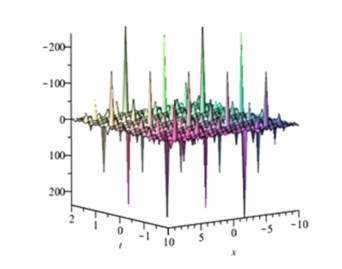









 DownLoad:
DownLoad:









